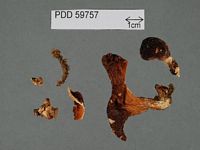|
 Pleurotus velatus Pleurotus velatus
BiostatusPresent in region - Indigenous. Endemic
Images (click to enlarge) | 
Caption: Dried type specimen
Owner: Herb PDD |
Article: Segedin, B.P.; Buchanan, P.K.; Wilkie, J.P. (1995). Studies in the Agaricales of New Zealand: new species, new records and renamed species of Pleurotus (Pleurotaceae). Australian Systematic Botany 8: 453-482.
Description: Basidiome caespitose. Pileus 30-10 x 20-80 mm, convex, sub orbicular to flabelliform;
surface dark grey, covered with fine greyish, floccose squamules when young,
smooth when old, drying deep orange brown (7E5, K & W); margin strongly
inrolled, with well developed velar remnants when young, less so with age, not
lobed. Lamellae drab white, drying greyish orange (6B6, K & W), in five
series, decurrent, very narrow, fairly thick, anastomosing towards stipe and
continuing down it as ridges. Stipe cylindric, solid, strongly excentric, up
to 20 mm long by 12 mm wide, pale brown with yellowish tinges towards lamellae,
tomentose to strigose towards base. Partial veil well developed, ephemeral,
fibrillose, not leaving a recognisable ring. Smell and taste not noticeable.
Spore print unknown.
Spores 6.5-10 X 3.5-4.5 (8.75 X 3.75) µm, Q = 2.3,
variable in size, oblong to oblong-cylindric, hyaline, sometimes with granular
contents, smooth, thin-walled, with a broad apiculus. Basidia 30-37 X 5-6 µm,
narrowly clavate, 2- and 4-spored. Cheilocystidia 8-25 X 3-8 µm, abundant, crowded
to form a sterile, lamellar edge, narrowly clavate to cylindric with a mucronate
apex, extending to a narrow finger-like process, sometimes with a small capitellum,
almost always surrounded by a drop of mucilage, sometimes the mucus from adjacent
cystidia merging to form an irregular blob with 2 or more capitella visible
inside. Digitate apical process with mucus blob often breaking away from apex
of cystidium and floating free, looking rather like a conidium. No true conidia
found on any part of basidiome. Pleurocystidia rare, broadly finger-like, aseptate
or sometimes uniseptate, occasionally branching at apex. Subhymenium up to 20
µm wide, of narrow pseudoparenchymatous hyphae. Trama irregular, monomitic,
with thin-walled, clamped hyphae, 2-6 µm in diameter. Context monomitic, of
thin-walled, interwoven hyphae with clamps, 3-7 µm in diameter, their walls
thickening with age, sometimes narrow-tipped with granular contents; a few oleiferous
hyphae present. Pileipellis a broad, repent cutis up to 50 µm wide, of narrow,
parallel, brownish, thick-walled hyphae, 3-5 µm in diameter. Young specimens
with a suprapellis of greyish, thin-walled, sometimes finely encrusted hyphae,
4-5 µm in diameter, with clavate ends (up to 7 µm in diameter) which make up
small squamules visible on pileus. Stipe tissue composed of hyphae 3-9 µm in
diameter, the broader ones thin-walled and with clamp-connections, the narrower
ones terminal, aseptate, with thick walls and a tendency towards arboriform
structure. Tomentose hairs towards base composed of bundles of thin-walled,
clamped hyphae of fairly uniform diameter (5 µm).
Habitat: On dead wood in coastal forest.
|